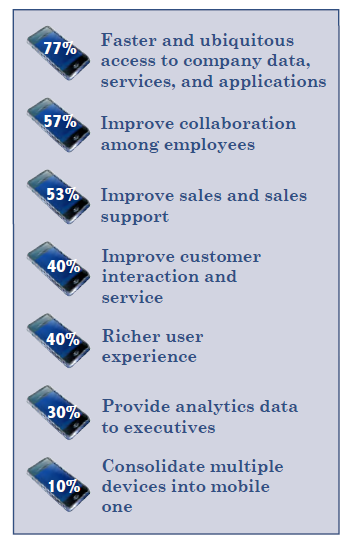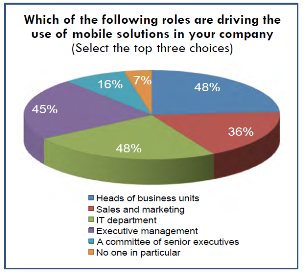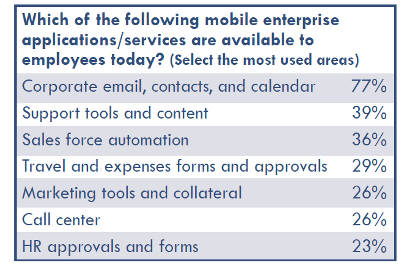The Sand Hill Group’s recent study, “Leaders in Mobility Strategies: Tug of War Between Business Risk and Value,” conducted interviews with 20 enterprise CIOs, CISOs, principals and vice presidents, and surveyed 85 enterprise executives in an online survey. The combination of these two research efforts provides unparalleled insight into strategies, lessons learned, use of BYOD policies, security issues, challenges and risks, cost analysis, pitfalls and best practices. In this article, we will share with you some of the most important takeaways from the study around the what, when, who and how of enterprise mobility adoption including data points from the survey.
The “how” of enterprise mobility adoption
How did enterprise mobility adoption evolve over the last 10 years? Adoption of enterprise mobile solutions and strategies came in three waves.
In Wave 1 enterprises focused on making common internal productivity applications available for mobile users. Personal Information Management (PIM) including email, calendar, and contacts became the “killer” applications driven mainly by the BlackBerry universe. Much of the enterprise world is still in this wave but moving rapidly forward to the next wave.
The iPhone, iPad, and the Google Android devices ushered in Wave 2. Enterprises realized that they can reach their customers (particularly in the B2C world) by developing user-friendly and rich applications.
In Waves 1 and 2 of the enterprise mobility spectrum, enterprises made their existing applications available in a mobile context and also experimented to see what value would come out of mobility.
We are now at the cusp of Wave 3, where some forward-looking enterprises innovate to discover that the greatest value of mobility is in enabling them to be more competitive in their markets so they can gain new customers and improve existing customers’ satisfaction. The 16 use cases and 6 case studies in the report clearly demonstrate that some companies are innovating their way to a significant competitive advantage.
The “why” of enterprise mobility adoption
Why are enterprises adopting mobility? What are the most important reasons for moving to mobility?
Most enterprises now operate in a 24/7 global environment and depend on mobility as key to timely, effective communications in such areas as:
- Sales and marketing field activities
- Customer support through real-time information
- Supply chain management
- Executives on the road
A lot of work these days is not tied to a desk or a desktop computer. Work also takes place in meetings, HR training sessions, collaborative team sessions, and lunch with customers. It’s obvious that these employees need instant access to the most important company data, presentations, and documents to be effective.
This hypothesis was validated by our survey results. When asked “What was your company’s most important reason for moving to enterprise mobility solutions? (Select all that apply),” the majority of the online survey respondents said it was faster access to company data followed by improved collaboration among employees.
The “who” of enterprise mobility adoption
Who is driving the adoption of mobility within the enterprise?
Unlike other enterprise technologies, driven by the IT group, employees are driving the pace of mobile adoption, wanting the same user-friendly computing at work that they enjoy outside of work. Importantly, our interviewees stated that a sizeable number of these employees are actually top executives. They were immediately attracted to the competitive benefits of iPads when they were first launched into the market.
Our online survey respondents also indicated that senior executive roles — heads of business units and executive management — are driving the use of mobile solutions in their companies. Study interviewees shared these examples:
- When a financial services company’s competitor showed up with an iPad at a mutual client’s office, the financial executive’s reaction was that he had to have an iPad in order to compete.
- When an airline pilot heard that another airline replaced paper flight plans with iPads in order to cut down on paper and increase efficiency, he looked into how to do the same thing at his company.
- At the U.S. Open, a bank used mobile devices to demonstrate the bank’s new deposit system to people waiting in line.
The “what” of enterprise mobility adoption
What applications and functional areas are adopting mobility in the enterprise?
Survey respondents identified functional areas in their company that currently use mobile devices the most. Almost half identified sales / sales support and information technology as the top areas. By far, corporate email, contacts, and calendar are the most available enterprise applications/services used in the survey participants’ companies. This indicates that many enterprises are still in Wave 1 of the enterprise mobility adoption spectrum.
Executives identified three areas among the “other” areas where mobile devices are most used in respondents’ companies: inpatient care, service delivery and management personnel for approvals and across disciplines.
Stay tuned for more of the study and survey results in future articles.
Kamesh Pemmaraju heads cloud computing and enterprise mobility research for Sand Hill Group. Follow him on Twitter @kpemmaraju.



